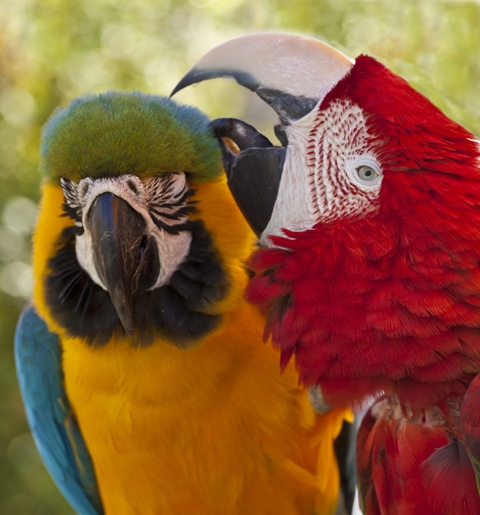It wasnt all that long ago that people used absolutely detrimental training techniques on their puppies. When the inevitable housetraining accident occured, people were advised to rub the puppys nose in it. When it got too rambunctious, you rapped it on the snout with a rolled up newspaper. When it barked, you squirted it in the face with water. Ughh!
How could any dog EVER learn to stop pooping in the house with this sequence of events
How is it even possible that a dog might be able to connect the vague dots tying the punishment to the crime? Wouldnt it perceive that there was objection to the poop itself rather than its location? Wouldnt it see its owners actions as aggressive and random?
It is nothing short of a miracle that most people were not mauled to death by the family dog as a result of their barbaric treatment. However, the dogs always forgot the deed and forgave their owners for their sins.
Suffice to say, dogs are different beasts than parrots; a parrot might forgive you for such an atrocity (after a long period of probation) but a parrot never forgets. He will tuck away for safe-keeping the idea that you might become untrustworthy again at any moment..and this may be used against you at any time.
It is safe to say that all animals learn in a similar fashion they do something, and the repercussions determine whether or not they will do it again. But there are big differences in the personalities of dogs and parrots.
For one, dogs aim to please their owners. You can see suffering in their eyes when we disapprove their actions and they go to great lengths to make amends with us.
A parrot doesnt much care if we approve of their behavior or not. They are very busy tending to those things that are important to parrots and it is merely unfortunate if our wants are overlooked in the process.
Its not that your parrot is bad or doesnt like you, its that parrots are self-serving by nature. They are thinkers, they have goals and priorities which they are inclined, sometimes instinctively, to carry out. Everything your parrot does has a purpose, even when we dont see an end to their means. This is the reason punishment is not only ineffective, but detrimental to a parrot.
Someone on facebook was bitten by their parrot recently. A friend linked her to an article in which the reader was advised to: Verbally tell your parrot no and place the bird back in its cage as a form of punishment. Cover the cage and leave it alone for some time. The parrot, being an intelligent bird, will sense that it is being disciplined.
This could not be further from the truth and its terrible advice. You cant discipline an animal that has no sense of right or wrong. Parrots only do what they do in the way that birds do things. They are free of conscience when it comes to their behaviors.
When your bird destroys your favorite book, it is carrying out an instinctive need to chew and shred. It does not weigh up its actions beforehand, or consider the consequences of getting caught.
If your parrot bites and screams it is trying desperately to communicate that something is wrong in the only way it has found to be effective. It certainly does get our attention.
Is your bird bad for doing these things? NO! It is being a bird, doing what comes naturally and handling matters in ways that seem to work. If you were to punish it, your actions would be perceived as aggressive because, to their way of thinking, they have done nothing to elicit YOUR behavior. Covering your bird or placing it in a dark room is counter-productive. It will be percieved as cruel and it is!
As intelligent creatures they do come to understand that their actions may meet with disapproval, but as they are simply carrying out the duties that nature has assigned to them, your objections may seem unreasonable.
This makes the word no absoluely pointless. In most cases, when a bird on a mission hears this, he knows you intend to reroute him away from his intended target and will actually race to acomplish the goal. Sometimes our hands become collateral damage. Bad bird? No. Just a determined bird.
In short, you cant punish a bird for acting in accordance to its nature. You will find much more success in detering unwanted behaviors by using distraction and avoidance:
Should your bird damage things that you love it is YOUR fault for letting him near something that is important to you. Remember, he is just being a bird often that means destruction.
The best form of distraction is training which lets you use their self-serving nature to your mutual benefit. One of the reasons birds respond so well to positive reinforcement training is because it gets something of value out of it.
Treats are earned and therefore it serves your bird to collaborate with you to get something it values. Birds, being very social animals, will also work for rewards like physical attention or praise that serves them too.
Over the years, we have seen many, many behavioral problems magically disappear when an owner begins training. Birds that are viewed as uncooperative or aggressive find a way to connect with their owners and turn their interests to this new means of getting things that are important to them.
As a result, these birds are all too willing to engage in activities other than the ones that landed them back in their cage prematurely. These happy and emotionally healthy birds have owners that allow them to be the birds that they are and avoid using unproductive measures of control like punishment.
Author Patty Jourgensen specializes in avian health, behavior and nutrition and has been working with and caring for rescue birds since 1987.
Time-Outs, Ladders, & Other Old Wife Tales
A cursory look up of parrot training methods reveals a number of long-standing customs that, upon closer inspection, might be considered forms of discipline. According to behavioral analysts, a punishment is any outcome that, when combined with an action, works to make that behavior less likely to happen again.
Let’s examine more closely at some of the typical suggestions that are made when seeking guidance on how to handle a challenging behavior issue:

We see time-outs take various forms with parrot training. Our attempts to implement time-outs include placing the bird back in the cage, turning out the lights, covering the cage, and banishing the bird to a distant room. These forms of discipline presuppose that the only thing that will motivate our bird to come out of its cage is to spend time with us. Since parrots are complex emotional creatures, it is impossible to make assumptions about their motivations or emotional states. Should the bird be experiencing fatigue, hunger, or anxiety, putting them in their cage might be exactly what they need. Perhaps our bird is acting out to get our attention because it truly wants it. Running over to pick up the bird in this case, even for a short while, and placing it back in the cage would teach it that acting out is a way to get attention.
Time-outs must be used right away following the behavior in order for them to be effective training techniques.
- To break the link between action and consequence, all it takes is the time it takes to either: a) pick up the bird and put it back in the cage or in a distant room; or b) run over and cover the cage or turn out the light.
- Second, the reason that initially sparked the bad behavior must be successfully eliminated during the time out. As we’ve already looked at, it’s nearly hard to pinpoint the precise reason behind our bird’s motivation at the precise instant before a behavior happens.
- Thirdly, in order to emotionally connect with the bird, time-outs should only last 30 seconds to a few minutes at most. If we leave it any longer, we run the risk of the bird forgetting why it was initially put away. Sadly, how often do we believe that putting our birds in special long-term cages is a justifiable way to “make the punishment fit the crime”? Perhaps their cries have been driving us crazy for an hour or more, and we just want some quiet time. Perhaps this was our first bite that broke our skin, so it was extremely painful for us. Even though we may initially think that our actions are justified given the situation, a closer look will show that our true subconscious motivation is actually retaliation.
- The bird needs to be put back in its proper location and given the chance to exhibit more appropriate behaviors in order to receive reinforcement. This is the fourth and final essential component to making time-outs effective. When we are training our parrots, this last step is the most important and the one that is most likely to be skipped or neglected.
We spend so much time worrying about what our birds should not do that we neglect to train them to engage in constructive substitute behaviors. Our bird will be more motivated to behave well than to act badly if we teach it that good behavior will result in rewards from us.
Trust Building Versus Trust Destroying
It is imperative that we ask ourselves this question prior to implementing any training program. By applying this straightforward standard to evaluate the methods mentioned above, we can see the possible harm they may bring about. Will the action I’m about to take strengthen or weaken the trust between my bird and me? The wonderful news is that there are alternatives!.
Dominance Theory Teaching an Old Alpha Dog New Tricks
Our innate perception of the “alpha” is what causes us to punish first and inquire later. Since the very beginnings of human society, there have always been people in positions of authority. Indeed, practically all extant examples of our closest relatives, primates, exhibit this alpha being. We could be said to be “hard-wired” to either dominate or be subjugated by other entities. Because of this deeply rooted programming, we are unable to recognize the options that studying the cultures of other animals provides. Steve Martin of Natural Encounters Inc. suggests asking ourselves, “Does my bird understand dominance/submission?” before employing dominance-based training techniques with our birds. states, “I have talked to many parrot field researchers whose profession is studying parrots in the wild,” regarding the topic of dominance in wild parrots. None of these specialists could remember ever witnessing aggression intended to establish dominance among wild parrots, nor could they recall ever witnessing any kind of hierarchy. .

The simple truth is that parrots do not fight to take up a higher position in the flock; instead, they fight to acquire or defend resources in the wild. Punishment is highly rewarding to the punisher! Punishment can only be considered effective if it actually decreases the target behavior, but due to incorrect application, this rarely happens. So why do we insist on using punishment and dominance whenever we encounter opposition in our parrots? Unfortunately, in rare cases, it does sometimes work. Owners will state that “the bird stops screaming (for a brief period of time) when they shake their bird’s cage.” Although the behavior is not actually changed (the bird continues to scream frequently), owners are encouraged by the short-term benefits. Punishment becomes a dangerously addictive training method when combined with the punisher’s innate feelings of resentment and subconscious desire for vengeance.
FAQ
How do you assert dominance over a bird?
How do you train a bad bird?